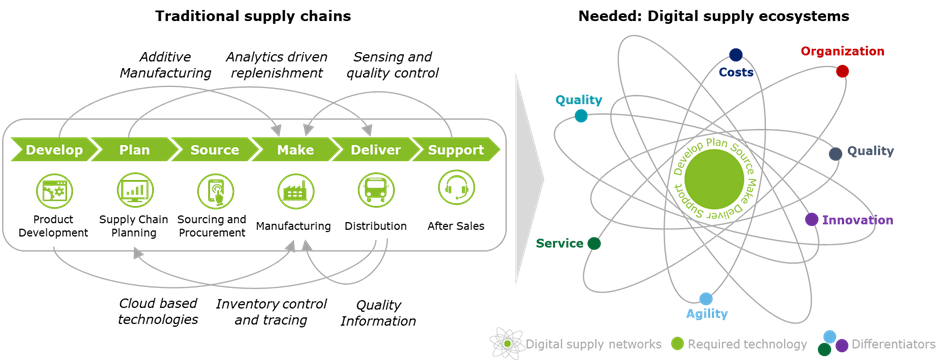Established companies are forced to address the digital transformation due to rapidly changing innovations and customer behaviour. In an uncertain, competitive and volatile environment, organizations must reconsider their existing business models through the identification and adoption of new technologies. Introducing the second part of our series on the future of supply chain, we take a closer look at digital supply chain ecosystems.
Established companies are forced to address the digital transformation due to rapidly changing innovations and customer behaviour. In an uncertain, competitive and volatile environment, organizations must reconsider their existing business models through the identification and adoption of new technologies. Introducing the second part of our series on the future of supply chain, we take a closer look at digital supply chain ecosystems.
Digital Supply Chain Ecosystem
Within most businesses today, the flow of information, money, and goods are often seen as isolated processes in segregated functions. Complexity and operational challenges increase with every additional stage. To enhance productivity and competitiveness, it is necessary to apply integrated management practices on basis of advanced information technology. Especially supply chain partner benefit from an alignment of these streams by optimizing the performance, stability and surplus of the overall value chain. Whereas supply chain management (SCM) and supply chain finance (SCF) offer a wide range of practical instruments and techniques, digital supply chain ecosystems inhere a disruptive potential for the development and deployment of data-driven business solutions (Figure 1).

Figure 1: Digital supply chain ecosystem compared to conventional supply chains
Data-driven Business Models
Mentioned by Burkett and Johnson (2016) as well as Otto and Oesterle (2015), it assumed that data driven business models will drive supply chains very soon to enable more efficient operations on basis of advanced algorithms. An integration of real-time data allows further an implementation of fully autonomous supply chains, which operate without human invention. (Schrauf & Berttram 2017, pp. 16).
The optimized processes lead to a to a significant reduction of lead times, while improving the overall shipping and inventory cost. Due to the constant information exchange, agility and resilience are further increased. This major shift in decision making and process automation has therefore fundamental implications for existing structures and organizations today.
The foundation of such algorithmic businesses is based on digital platforms, known as supply chain ecosystems, and represents the next stage of integration according to recent technical developments. IoT, for example, creates value by automating simple task. Sensors allow to trace and track sensitive information that anticipate changes during the shipment. Where the concept is already in practice, it is very likely that technical requirements, with regards to data security, as well as data handling, will exponentially grow.
Collaboration and Cooperation
Over the last years the need for digitalization and interconnectivity has forced companies to adapt their business model. Supply chain practitioners should take these implications into consideration and should build the relevant capabilities. The long-term goal lies therefore in an end to-end digitalisation of the supply chain to streamline the basic processes, risks, and financial flows properly. On this basis, a shift away from an isolated view is necessary. To cope with these challenges, independent companies are required to coordinate and collaborate with each other to create digital supply chain ecosystems.
Target customers and stakeholders of our easyCMR application:

Figure 2: Collaborative data sharing across the easyCMR ecosystem
We from BitCargo created easyCMR as a tool that adds value to your logistics processes by saving costs and time, but also allowing a secured and easy data sharing across our ecosystem that involves also relevant actors in the public sector (Figure 2).
Get in contact with us to become part of this ecosystem. In our next blog, we dive deeper into Blockchain-driven logistics use cases. Stay tuned!
Sources:
- Burkett, M. & Johnson J. (2016): Supply Chain 2025: Planning Today for Published: 6 July 2016. Garnter http://www.gartner.com
- Otto, B. & Österle, H. (2015). Corporate Data Quality – Voraussetzung erfolgreicher Geschäftsmodelle. 1st Edition, Berlin: Springer.
- Schrauf, S. & Bertram, P. (2017). Industry 4.0: How digitization makes the supply chain more efficient, agile, and customer-focused. PriceWaterhouseCoopers Link: https://www.strategyand.pwc.com/media/file/Industry4.0.pdf (Access: 11/07/2017).

